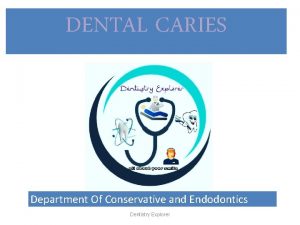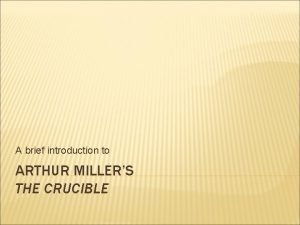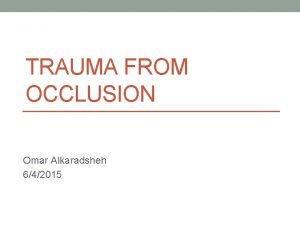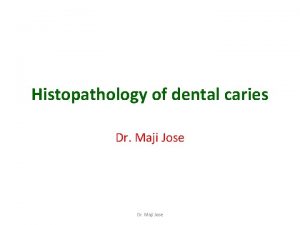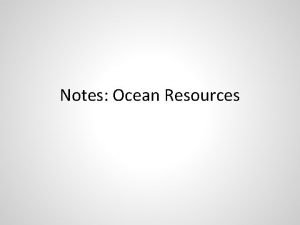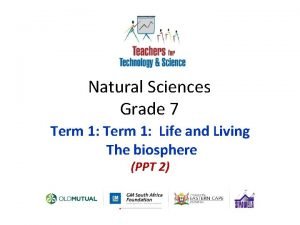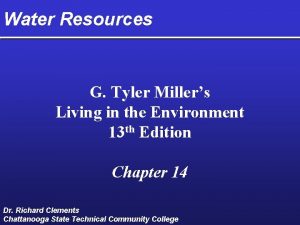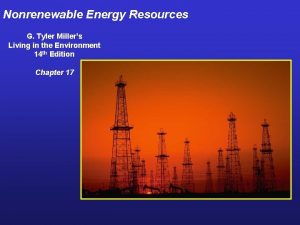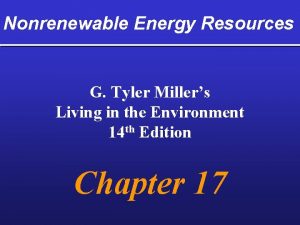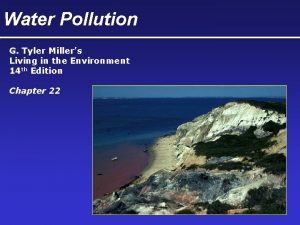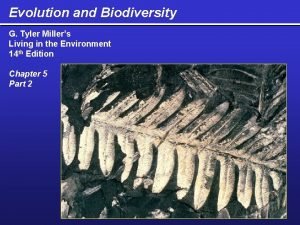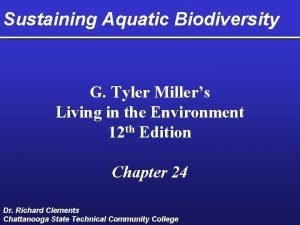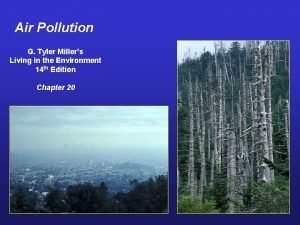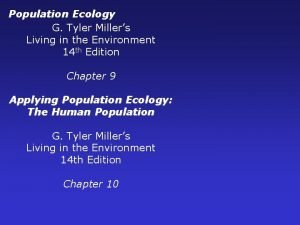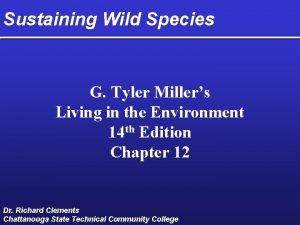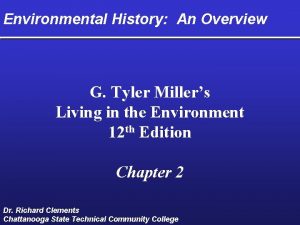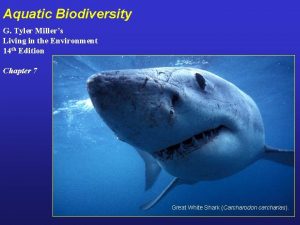Water Resources G Tyler Millers Living in the
















- Slides: 16

Water Resources G. Tyler Miller’s Living in the Environment 14 th Edition Chapter 15

Key Concepts Ø The physical properties of water Ø Availability of fresh water Ø Methods of increasing freshwater supplies Ø Using water more efficiently Ø Problems associated with flooding

Water’s Unique Properties Ø Hydrogen bonding Ø Liquid over wide temperature range Ø Changes temperature slowly Ø High heat of evaporation Ø Great dissolving power Ø Filters out ultraviolet radiation Ø Adhesion and cohesion Ø Expands when it freezes

Supply of Water Resources Freshwater Readily accessible freshwater Groundwater 0. 592% Biota 0. 0001% Lakes 0. 0007% Ice caps and glaciers 0. 592% 0. 014% Fig. 15 -2 p. 307 Soil moisture 0. 0005% Rivers 0. 0001% Atmospheric water vapor 0. 0001%

Surface Water Ø Surface runoff Ø Watersheds Ø Reliable runoff

Ground Water Fig. 15 -3 p. 308 Flowing artesian well Precipitation Well requiring a pump Evaporation and transpiration Evaporation Confined Recharge Area Runoff Aquifer Infiltration Stream Water table Infiltration Lake Unconfined aquifer Less permeable material such as clay Confined aquifer Confirming permeable rock layer

Use of Water Resources Ø Humans use about 54% of reliable runoff United States Ø Agriculture Ø Industry Power cooling 38% Ø Domestic Agriculture 38% Ø Power plants Fig. 15 -4 p. 309 Industry 11% Public 10%

Too Little Water Ø Dry climate Ø Drought Ø Desiccation Acute shortage Ø Water stress Fig. 15 -6 p. 310 Adequate supply Shortage Metropolitan regions with population greater than 1 million

Using Dams and Reservoirs to Supply More Water: The Trade-offs Large losses of water through evaporation Flooded land destroys forests or cropland displaces people Downstream cropland estuaries are deprived of nutrient-rich silt Downstream flooding is reduced Reservoir is useful for recreation and fishing Can produce cheap electricity (hydropower) Fig. 15 -9 p. 313 Migration and spawning of some fish are disrupted Provides water for year-round irrigation of cropland

Transferring Water from One Place to Another Ø Watershed transfer CALIFORNIA Sacramento River Ø California Water Project North Bay Aqueduct UTAH Sacramento San Francisco South Bay Aqueduct Ø Central Arizona Project California Aqueduct Ø James Bay NEVADA Shasta Lake Fresno Los Angeles Aqueduct Los Angeles Colorado River ARIZONA Central Arizona Project Phoenix San Diego Colorado River Aqueduct Tucson MEXICO Fig. 15 -13 p. 317

Tapping Groundwater Ø Year-round use Ø No evaporation losses Ø Often less expensive Ø Potential Problems! Refer to Fig. 15 -15 p. 319

Problems with Using Groundwater Ø Water table lowering (See Fig. 15 -15 p. 319) Ø Depletion (See Fig. 15 -16 p. 320) Ø Subsidence (See Fig. 15 -16 p. 320) Ø Saltwater intrusion (See Fig. 15 -17 p. 320) Ø Chemical contamination Ø Reduced stream flows

Converting Salt Water to Fresh Water and Making it Rain Ø Distillation desalination Ø Reverse osmosis desalination Ø Desalination is very expensive Ø Cloud seeding

Using Water More Efficiently Ø Reduce losses due to leakage Ø Reform water laws Ø Improve irrigation efficiency (Fig. 15 -20 p. 324) Ø Improving manufacturing processes Ø Water efficient landscaping (xeriscaping) Ø Water efficient appliances

Too Much Water: Floods Ø Natural phenomena Ø Aggravated by human activities Reservoir Dam Levee Flood wall Floodplain Fig. 15 -24 p. 327

Solutions: Achieving a More Sustainable Water Future Ø Efficient irrigation Ø Water-saving technologies Ø Improving water management See Fig. 15 -26 p. 329
 Water and water and water water
Water and water and water water Millers right angle technique
Millers right angle technique Millers pyramid
Millers pyramid Liquefaction foci of miller
Liquefaction foci of miller Dentistry
Dentistry Arthur millers drama fra 1953
Arthur millers drama fra 1953 Tooth mobility classification
Tooth mobility classification Karen millers
Karen millers Turbid dentin
Turbid dentin Robin hood's merry men
Robin hood's merry men Whats an energy pyramid
Whats an energy pyramid Is moss living or nonliving
Is moss living or nonliving Living non living dead
Living non living dead Smallest living unit
Smallest living unit Notesocean
Notesocean Biosphere grade 7
Biosphere grade 7 Transformation process
Transformation process




